Nambu
World: Order of the Sacred Treasure
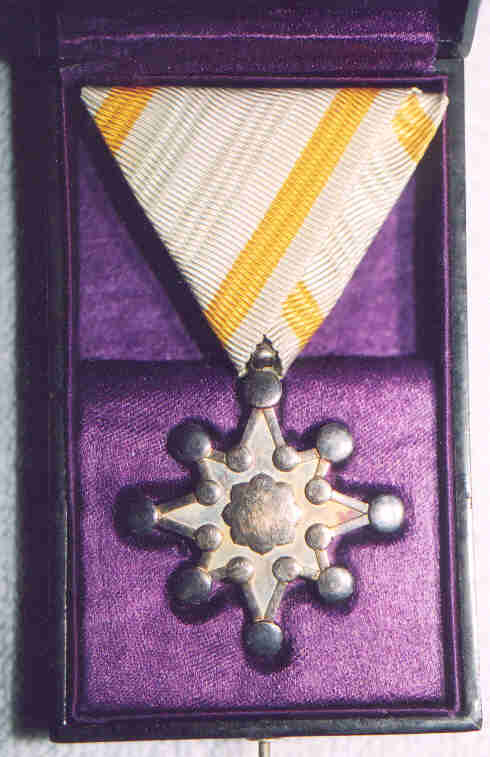
This medal came in eight classes,
with the different classes awarded to different ranks. The one shown here is 8th
class, the lowest. Seventh and eighth classes were the only ones available to
enlisted men. The Japanese name of this order is zuihosho. I believe the
“Treasure” in the name is a reference to the three sacred treasures that
Japanese myth says the sun goddess Amaterasu gave to the first emperor of
Here is the inscription on the back.
It reads from top to bottom, right to left (i.e. upper right, lower right,
upper left, lower left). It says kun-ko ki-sho, which means “meritorious deed ribboned medal”.
The characters are very old fashioned and hard to read, as they bear little
resemblance to the modern way of writing them. Kun means merit, and sho means
medal, so the general term for a merit medal is kun-sho.

This is the front of the case. The
inscription, again in very old-fashioned style characters, reads kun-hat-to-zui-ho-sho. Literally this
means “merit-eight-class-congratulations-treasure-medal”, or more colloquially,
Eighth Class Order of the Sacred Treasure.

The top hinge on the case has come loose.

It looks like there should be a little clasp or
plate that goes around the peg to hold it shut.
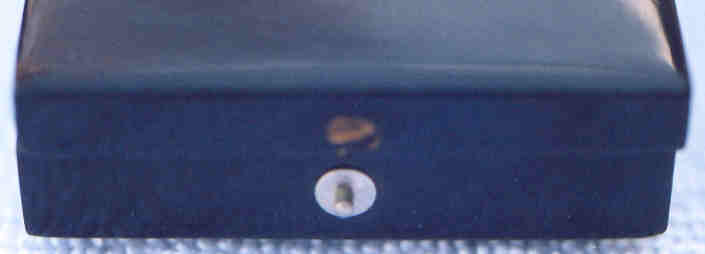
This certificate measures 590mm X
448mm (23-1/4” X 17-5/8”). It is made of a fairly heavy weight paper. It has
the standard two watermarks, a chrysanthemum in the upper right corner and a
cherry blossom in the lower left corner (shown below). There is nothing printed
or stamped on the back. The little dots (three along each side, top, bottom and
middle) require a brief explanation. This certificate is strongly curled and
would not lay flat. I therefore used my special equipment for such situations:
a flat steel strip under each side and three ¼” rare-earth magnets to hold the
edges down and prevent them from curling. I painted the magnets using Humbrol
#148 flat tan enamel to make them less conspicuous (they come with shiny nickel
plating).

The most important information is on
the right side, which records the recipient’s name and the date of the award.
The writing is in vertical (top down) columns, starting at the right and
working across towards the left. Here is the text in Japanese, followed by a
translation:
First
column on right: ten-yu-o-ho-yu-shi-ban-sei-ik-kei-no-tei-so-o-fu-meru
Second column from right: dai-nippon-tei-koku-ten-no-wa-o-i-gen-za-buro-o-mei-ji
Third column from right: kun-sho-no-kun-hak-kyu-ni-jo-shi-zui-ho-sho-o-jo-yo-su
Fourth column from right: sunawa-chi-kono-i-ni-zoku-suru-rei-gu-oyo-bi-tok-ken-o-yu
Fifth column from right: seshimu
Sixth column from right: jim-mu-ten-no-soku-i-ki-gen-ni-sen-go-hyaku-kyu-ju-ni-nen
Seventh column from the right: sho-wa-nana-nen-shichi-gatsu-ni-ju-kokono-ka-to-kyo-tei-kyu-ni-oi-te
Last column on left: ji-o-?-seshimu [I could not identify the third symbol from the top, though the meaning is clear both from the context and the OMJAS translation].
I was somewhat lucky because OMJAS translates a certificate for another medal with similar (but not exactly the same) wording on pages 20-21. However, I have not followed their translation very closely. Here is my translation of this certificate:
“The Emperor of Greater Japan, having come to the Imperial
throne in an unbroken Imperial line with divine guidance, confers the Meiji
Order of Merit, Eighth Class, and awards the Order of the Sacred Treasure to
Genzaburo Oi [surname Oi] along with the honours and privileges
appurtenant thereto. The Imperial Seal has been affixed in the
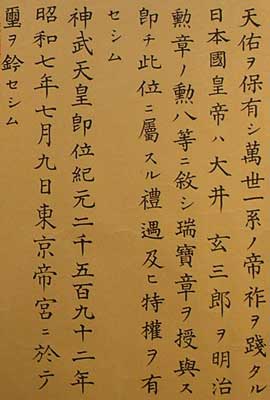
The left side has the formalities
from the Board of Decorations. Surnames are underlined in the following
translations. The big round red seal at the top says dai-nip-pon-tei-koku-sho-kun-kyoku-in, “Seal of the Board of
Decorations of the Empire of Greater Japan”. The first column on the right has
the date, July 9, Showa 7 (1932). The second column says sho-kun-kyoku-so-sai-sho-yon-i-kun-ni-to-shimo-jo-yasu-maro:
“President of the Board of Decorations Yasumaro Shimojo, Fourth Rank,
and holder of the Second Order of Merit. The third and fourth columns say kono-sho-o-dai-nana-ju-roku-man-nana-hyaku-roku-ju-yon-go-o-motte-kun-to-bo-satsu-ni-ki-nyu-su:
“We have entered number 760764 in the Register of Grades of Merit” (this is the
number of the certificate). The last column on the far left says sho-kun-kyoku-sho-ki-kan-ju-go-i-kun-roku-to-i-de-hitoshi:
“Secretary of the Board of Decorations Hitoshi Ide, Junior Fifth Rank,
Holder of the Sixth Order of Merit”. The square-ish red seals at the bottom
repeat the titles (President and Secretary) of the individuals whose names are
affixed. Such seals are often used instead of signatures in
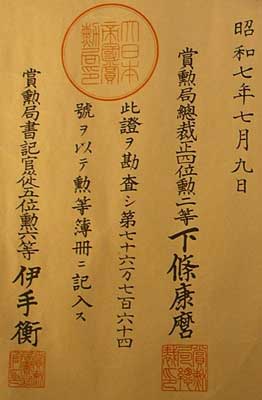
This close-up of the artwork at the top-middle
of the certificate has the Imperial Chrysanthemum in the centre and paulownia
leaves in the border on either side. This kind of scrolly, flowery border is
Western-influenced.
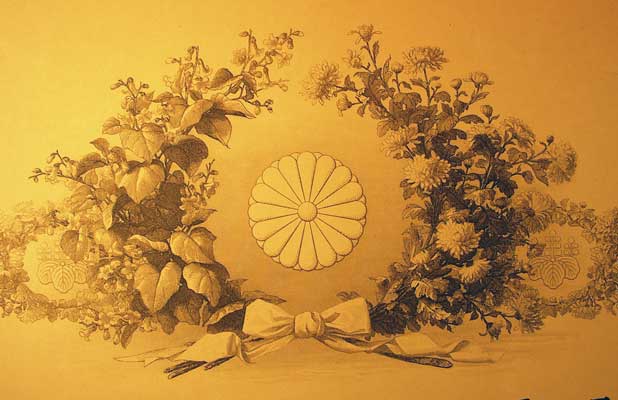
The big red seal in the centre reads
from upper right down, then upper left down. First (right) column: dai-nip-pon. Second (left) column: koku-ji. Together it means “Imperial
Seal of Greater Japan”. The kanji in the lower left, ji=Emperor’s seal, gave me some trouble, as it is rather rare and
written in an ancient fancy script style. I finally realized that it was the
same as a printed character on the right side of the certificate and was able
to find it on page 55 of Nelson’s Japanese-English
Character Dictionary, Second Revised Edition, where it is kanji #71.
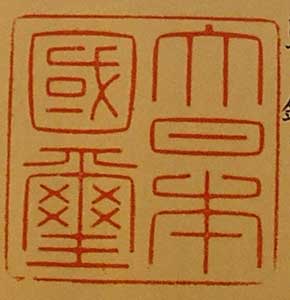
Here is a close-up of the artwork in
the bottom-centre of the certificate. Note the colour of the ribbon, which is
not the same as the colour of the actual ribbon on this medal.
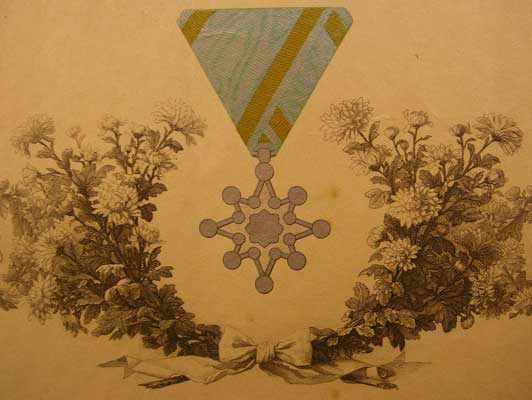
In this close-up of the lower left
corner you can see that the border is made up of alternating Imperial
Chrysanthemums and paulownia leaves, another symbol of the Imperial family.

This is the watermark in the upper
right corner. It is the Imperial Chrysanthemum. The photo appears very orange
because I had to put an incandescent lamp directly behind the certificate to
get the watermark to show up and to have enough light to get a shutter speed
that would allow a clear, sharp shot.
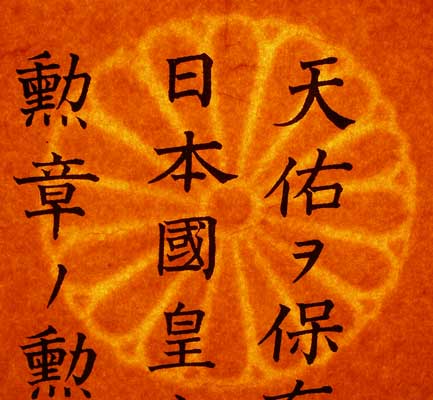
This is the much smaller watermark
in the lower left. It is a sakura
(cherry) blossom with the character in (short
for insatsu=printing) inside it. I
think that means the certificate was printed by the Government Printing
Department of the Empire of Greater Japan.
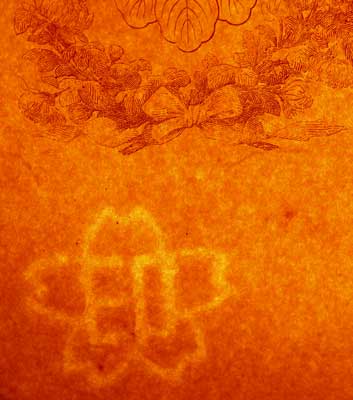
To
return to the base page on Medals, please click here: Nambu World: Japanese Medals
To return to “Other Japanese
Militaria”, please click here: Nambu World: Other Japanese
Militaria
To return to the home page, please
click here: Nambu
World: Teri’s WWII Japanese Handgun Website
Last updated: July 29, 2006. All contents are copyright Teri unless
otherwise specified and may not be used elsewhere in any form without prior
permission.